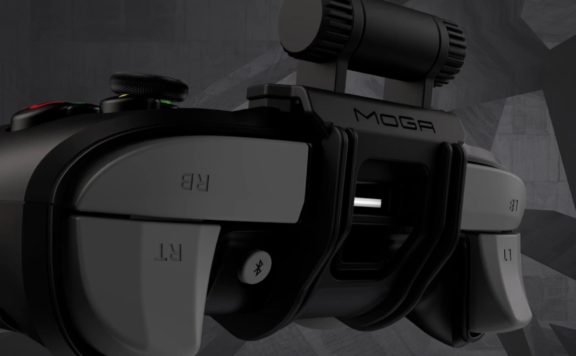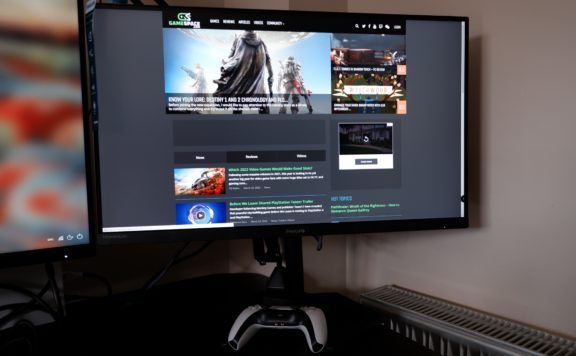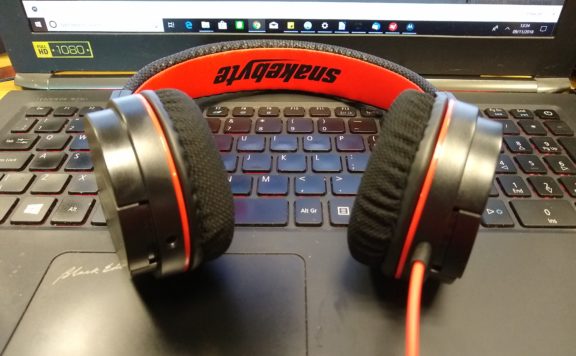The Maono PD400X is a multi-purpose XLR/USB dynamic microphone aimed at almost every potential streaming setup. Available now at an SRRP of around $169.99 or local equivalent, the Maono PD400X looks to be everything to all gamers. Whether you’re ready to dabble in some high-end audio, sing when you’re winning, or just talk to Twitch, the PD400X USB/XLR seems to have it all. Featuring a whole range of connectivity, tons of compatibility, and a myriad of physical configurations, the specifications for this dynamic mic make it more than the average pickup and play.
Specifications
Capsule Type: Dynamic microphone
Polar Pattern: Cardioid
Connectivity: XLR, USB-C, 3.5mm monitoring jack
Mic Gain Range: 0 to +42dB
Sampling Rate: 48kHz / 24bit
Frequency Response: 20Hz-20kHz
Sensitivity: XLR:-51dBV / USB:-8.5dBFS/Pa(Max)
SPL: >130dB SPL
Out The Box
Once the surrounding cardboard container is discarded, the PD400X certainly manages to impress. The yellow and black Maono motif decorates the rest of the packaging around this microphone. While the protective foam doesn’t appear to be recyclable it does do a wonderful job of keeping everything protected. Slotted into the aforementioned packing is the PDX400 microphone, accompanied by a desktop stand, mic cover, adequate documentation, USB-C cable, and XLR cable.
Upon plucking out the PDX400 out of the box, this immediately feels like a premium object. A metal cylinder at the core of this setup houses all the essential electronics, and it has a reassuring heft. Roughly 2 Kg / 4 Pounds of audio accessory is split between a brushed black housing and a cylindrical grille across the top. This is held in place and protected by a solid outer skeleton, all of which can be hidden away using the included foam shield. The gloss ring around the center of the might detract from an otherwise clean aesthetic, but this houses a capacitive mute button and status LEDs, a really lovely little touch that just helps it stand out. Even the volume control and plastic base don’t detract from the singular aesthetic, managing to stay hidden away or inconspicuous enough as to not ruin the overall flow of this design.
The rest of the PD400X continues with a similarly premium feel. A pair of metallic legs hold everything in place using plastic topped screws with the Maono logo etched into either side and a detachable base that hides the ⅜” and ⅝” screw thread interface inside the stem of the stand.
Maono has already shown that it can stand out from the pack with the unusual one armed effort of the DM30. It would be nice to see something as unique here but this is hardly a deal breaker. Similarly, small tweaks to the branding on the Maono branding on the side or the plastic bottom would elevate this mic even further, from an already impressive start.
Fully assembled, the PDX400 looks great. The impressive construction coupled with little details, like the black embossed XLR jack and the custom screw heads, means this microphone won’t beat out the latest RGB-enhanced keyboard for attention, but it certainly will feel right at home with equipment that costs twice as much.

Setup
Assembly, either as an arm-mounted mic or on a desktop takes little to no time at all, and getting started isn’t particularly difficult on PC. Hooking up the bundled XLR cable to an existing audio interface means no additional
add ins and instant incoming sound. USB connectivity is largely a plug-and-play experience too and gives a great deal of flexibility for those who don’t daily drive dedicated audio equipment.
Sound
We coupled our PD400X with an M-Audio Air 192-4, giving us an adequate range and bit depth to make full use of the Maono’s specifications. No mixer or pre-amp was added to ensure minimal interference with the performance of the mic. When compared to more common condensers, this dynamic cardioid design should result in better noise reduction from extraneous sources and a well-balanced sound. Maono claims that the PD400X manages a fairly flat response without being overly bass-heavy.

We ran our desktop sample through a quick and very unscientific frequency response test, blasting it with pink noise from whatever we had on hand. Even with a pair of speakers that knowingly make compromises in an environment that wasn’t prepared for testing, Maono’s claims seem to be reasonably close to reality and the PD400X is consistent given our sub-optimal setup out of the box.

When pitting this against my daily driver or gaming headset, the PD400X is an entirely different class of audio equipment. While configuration through an audio interface might take more tweaking than a fold-down headset arrangement, the difference in quality is easy to appreciate. Once levels are set, there’s a very natural balance to the spoken word and there’s a very definite drop-off beyond the cardioid pickup pattern. I manage a very Scottish drawl that is bass heavy. The result is a clear, natural, decently balanced reproduction of my own utterings without much interference. When we returned to a busier room, air conditioning and the noise of cats mid zoomies were both negligible, while the dynamic mic managed far less pop than I’d expect from a condenser equivalent. Despite this, energetic keyboard warriors or heavy breathers might require more tweaking to gate the background noise away.
USB-C connectivity provides a similar, if not identical, sound across a wide range of devices. Where you might not have an unwieldy audio interface or the mixing tools to get e perfect levels, the PD400X can still perform. While the purist might opt for phantom power, there are many features that make a compelling case for just using the PD400X as a plug-and-play mic. Aside from the solid tone and consistent response, USB-C connectivity powers up the combination volume and gain knob on the front of the mic. A capacitive mute control and LED indicator come alive in this mode, and three onboard EQ modes can be used at the press of a button. These features are fantastic if you’re looking to sound overly suave in a Zoom meeting, but the Maono Link software is still a highlight of the USB-connected experience.

Available on OSX and Windows platforms, the bundled software adds basic and advanced configuration modes that pale in comparison to a fully-fledged mixer but make it easy to get to grips with more microphone than a Discord server needs. The standard mode opens up a few easy access buttons that focus on the most important aspects of tone, setup distance, and volume, while Advanced configuration moves on just enough to give quick control of the audio upstream. Flat, high pass, and presence boost filters are all available via the onboard EQ buttons or software EQ, although additional gain, limiter, and compression sliders mean the majority of most interface options are replicated. Sure, the Maono Link isn’t nearly as feature-filled as Blue software, but this black and yellow brand manage a nice balance for beginner, intermediate, and enthusiast.
Impressions
The diversity offered by Maono’s PD400X is possibly one of its most compelling features. The other is its price point. The PD400X slots in at a significant amount more than the PD100U dynamic USB microphone and hits the market at around the same price range as the Yeti-X. Instead of a dozen Warcraft voice modes or customizable RGB, the PD400X provides onboard EQ, a mic that’s going to handle background noise better, a cleaner aesthetic, a great sound for broadcasting, and an arguably better mounting options via the internal stand threading. If you’re looking for a microphone that sounds broadcast-ready, but with the option to step up your stream later on, consider getting the PD400X now. It will get you started with minimal fuss and then be ready to support an interface and mixer later down the line.
The Maono PD400X is available now via the Maono website and major retailers, where you’ll regularly find it on sale.







